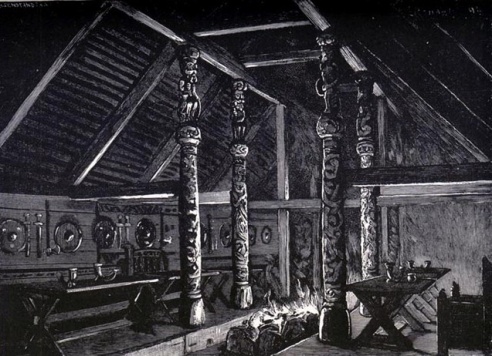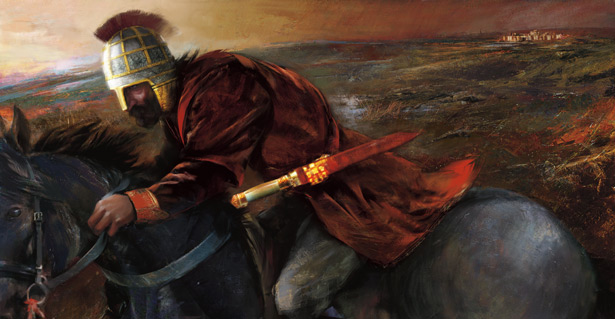Week 32 in the Year of Drinking Adventurously. Mead.
A drink for a Viking, sure. But mead is not just for Vikings or Asgardians or characters out of fantasy novels. Mead is one of, if not the most ancient of the potent potables we will encounter on this adventure. The chemical remnants of mead have been detected in earthen pottery vessels discovered in Northern China, dating from 7000-6500 BC.
Mead has been referenced in a sacred book of the Vedic religion dating from 1700-1100 BC. The Ancient Greeks drank it–both Aristotle and Pliny the Elder talk about mead– and of course the Gaelic, Brythonic and Scandinavian peoples consumed it and made it ‘famous.’ Mead and mead-halls are central to the scene of Beowulf, for example. The Kanu y Med or ‘Song of Mead’ is a poem attributed to the Welsh bard Talliesin, who lived around 550 AD and Y Gododdin, a poem attributed to Aneirin, one of Talliesin’s contemporaries describes mead drinking and feasting in the mead-halls of ancient Edinburgh.

There are many styles of mead to choose from. In fact, a trade group of American meaderies –yes that’s a thing– lists 41 official styles of mead as of the 2015 publication of our guide. Not in time for this post, much to my chagrin, I discovered that there is a meadery not far from where I live. However, the upcoming weeks have some really unusual offerings so I might revisit this week during one of those. In the meantime, I have a bottle of Bunratty Mead from Ireland to imbibe. And yes, its something I keep on hand. And no you shouldn’t be surprised it’s an Irish mead. (You do read this blog, don’t you?)
As with most things Irish, there are legends associated with mead. After mead was introduced to the Four Kings of Ireland it soon became the drink of choice at court. But it was not reserved for just the nobility. Believing it to be imbued with the powers of virility and fertility, mead was to be drunk by the bride and groom for one full moon after their wedding day. Thus the term “honeymoon” was born.
Mead can be served neat, over ice or even warmed to just short of boiling on cold winter’s night. I prefer mine in a drinking horn, sitting around the trestle table sharing stories of glorious battle with my comrades. So skål! Or slainté! And lift your goblets and let us eat meat and drink mead at our Lord’s table for tomorrow we go out and conquer! (Or go to the office and answer e-mails all day… Whatever.)
Go see how that feisty wench Lula ól sí mea!



Fascinating. I have never liked mead … but a couple of my friends brew it at home … mead it / made it, perhaps.
LikeLiked by 1 person
Personally, I like it better served warm in the winter. It’s so sweet. Which surprises me that all those toughly warriors drank it! 😀
LikeLiked by 1 person
Sort of sweet and sour! Sweet and sickly-stickly, if I remember.
LikeLiked by 1 person
Yes it can be. Not everyone’s taste for sure!
LikeLike
I never tried mead, but it does sound intriguing…
LikeLiked by 1 person
Wendy and her husband are going to attempt mead making with their own honey! Isn’t that cool? Truly, mead is another one of those cold weather drinks for me. It’s very sweet and can be a little much for hot weather. But on a cold winter night? Perfect!
LikeLiked by 1 person
Well, you owe me a Rodan Red, and I’ll now pester Wendy for some mead. 😀
LikeLiked by 1 person
You’re right! And a Godzilla Gold, too! 😀 Actually the home brewing is really going well. I’ll probably fill in one of the upcoming weird booze days with an update.
LikeLiked by 1 person
I’d like to read about that!
LikeLiked by 1 person
I’m glad! It’s coming soon!
LikeLiked by 1 person
You had me at ‘Viking.’ Lol. Really interesting post! Right on. 😉
LikeLiked by 1 person
Thank you! It was interesting to research. Not all of these booze posts give me the opportunity to indulge my love of history!
LikeLike
Welcome. Right? Booze and history lessons. Right up my street. Respect. 😉
LikeLiked by 1 person
Haha! Awesome!
LikeLike
I like a Mead, but I’m small doses. It’s a good choice during colder months though. Interesting history behind it. 😃
LikeLiked by 1 person
Anything Medieval, Anglo-Saxon, Viking related and I’m hooked! But yeah, mead is a winter time drink for me.
LikeLiked by 1 person
Never had it near-boiling, but I do like it room temp. The only type of beer I don’t prefer ice-cold.
LikeLiked by 1 person
Its like a hot toddy! Good for what ails ya!
LikeLiked by 1 person
May have to try it. Winter sucks, so that may be good for what ails me in January. 😃
LikeLiked by 1 person
I hear ya!
LikeLiked by 1 person
Interesting!! I’d never heard of it. Sounds delicious.
LikeLiked by 1 person
Ancient and wrapped up in history! I like it best in the winter. It’s very sweet.
LikeLiked by 1 person
I’ll have to try it….thanks for sharing!
LikeLiked by 1 person
I’ve never had it but now I feel I must! You might be an enabler, Meg! 😝 Interesting history too. I didn’t know that about the honeymoon.
LikeLiked by 1 person
Oh, I hope I’m not a bad influence! Really… 😈
LikeLiked by 1 person
Ha ha! Oh, I’m sure you do. 😄
LikeLiked by 1 person
Yes, I liked the history behind it. How interesting, can’t quite imagine the taste of fermented honey…
LikeLiked by 1 person
It’s like sweet wine. Not something I’d drink every day, but a pleasure on a cold winter night!
LikeLiked by 1 person
I love that this is where the term honeymoon came from! And I have traffic court next week… I wonder if this would help?
LikeLiked by 1 person
Yeesh! Well it can’t hurt! 😧
LikeLiked by 1 person
Oh! This is a drink I actually like! In my twenties, there was a period of time when, for my small group of friends, mead was our ‘thing’.We went to this tremendously cool place to enjoy it. But perhaps my favorite place to enjoy it would be beside Thor in Asgard. Okay, not perhaps… 😀 Perhaps you can join us… maybe his brother will be there. 😛
LikeLiked by 1 person
Now that’s what I’m talking about! 😍
LikeLiked by 1 person
Then, of course, Thor can come here for coffee… because… “This drink… I like it… ANOTHER!” (I so love that part… I still laugh even though I’ve seen that movie, like, 30 times…)
LikeLiked by 1 person
Oh yeah! Absolutely funny every time!
LikeLiked by 1 person
Excellent bit of history there…did you know I have a passion for the Icelandic sagas and the Eddas?
LikeLiked by 1 person
Really? No I didn’t. Your interests are quite broad and varied! That’s really cool, I’ve only dabbled in this pool. Beowulf and The Last Kingdom. A little nonfiction and mythology. You are astounding me!
LikeLiked by 1 person
I have always had a big interest in Norse mythology… I mention Odin a couple of times here and there, the Icelandic sagas are speculatar, the largest body of prose narratives in the vernacular in the Middle Ages, proto novels. Early Iceland is fascinating as well, with no formal government only a legislative branch for almost 3 centuries it is a good example of a form of anarchism
LikeLiked by 1 person
Fascinating! I wish I had time to explore everything I find interesting. I know bits and pieces of things because I get so easily distracted by the next ‘shiny’ thing.
LikeLiked by 1 person